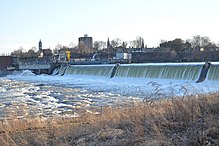| Holyoke Dam | |
|---|---|
 Holyoke Dam during spring thaw | |
| Country | United States |
| Location | Hampden County and Hampshire County Massachusetts |
| Coordinates | 42°12′49″N 72°36′06″W / 42.21361°N 72.60167°W |
| Purpose | Power, regulation, industrial |
| Status | Operational |
| Construction began | 1895 |
| Opening date | 1900 |
| Construction cost | ≈$1,000,000 (1900)[1] |
| Built by | Fruin-Baurbrick H. S. Hopkins, St. Louis[2] |
| Owner(s) | Holyoke Gas & Electric |
| Operator(s) | Holyoke Gas & Electric |
| Dam and spillways | |
| Type of dam | Granite gravity |
| Impounds | Connecticut River |
| Height (foundation) | 30 ft (33.5 ft while rubber bladder is inflated) |
| Length | 1,020 ft (310 m) |
| Elevation at crest | 94.6 ft (28.8 m) |
The Holyoke Dam, also referred to as the Hadley Falls Dam, or Hadley Falls Station is a granite dam built in tandem with the Holyoke Canal System at Hadley Falls on the Connecticut River, between Holyoke and South Hadley, Massachusetts.[3] The water differential created by the dam produced mechanical hydropower for industrial uses in Holyoke, and later hydroelectric power.
The current dam is the third structure to be built across the Great Falls at South Hadley. [4] The dam, along with the Canal System and its Testing Flume, is recognized by the American Society of Mechanical Engineers as a Historic Mechanical Engineering Landmark for its use by Clemens Herschel in the development of the Venturi meter, the first means of measuring large-scale flows, and the McCormick-Holyoke Turbine by John B. McCormick, also known as the Hercules Turbine, which doubled the efficiency of turbines to more than 80% in its time.[5]
- ^ "Supreme Court Decision on New Dam Taxation". Springfield Republican. Springfield, Mass. January 31, 1900. p. 8.
The Holyoke water-power company has completed a fine new dam at a cost of $1,000,000, more or less
- ^ "Contract for the Dam Signs; Structure to be Built by the Fruin-Baurbrick Construction Company and H. S. Hopkins of St. Louis". Springfield Republican. Springfield, Mass. February 26, 1895. p. 5.
- ^ "— Holyoke's Dam Disaster of 1848". 17 February 2012.
- ^ "LIHI Certificate #89 - Holyoke - Low Impact Hydropower Institute". lowimpacthydro.org.
- ^ "Holyoke Water Power System". American Society of Mechanical Engineers. Archived from the original on August 28, 2018.
